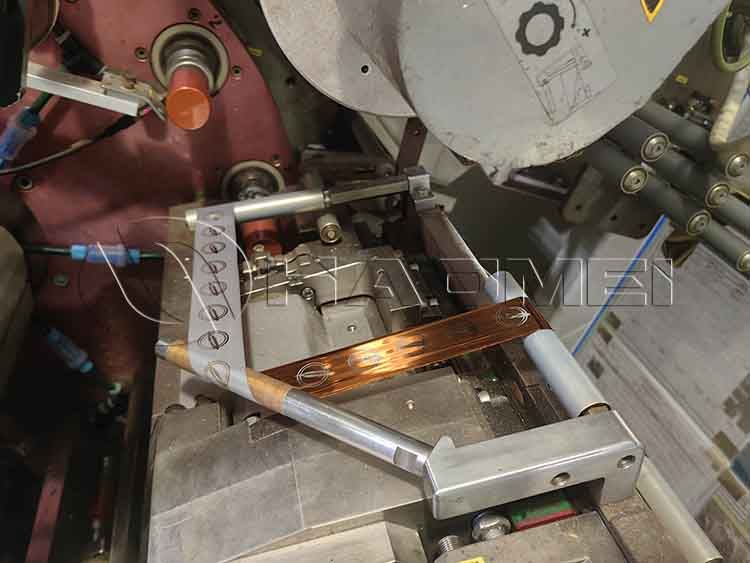





2025-06-30
The first step in the production of aluminum ROPP caps is to carefully select aluminum plates. Common alloys include 3105, 8011, etc. 3105 aluminum plates belong to 3 series aluminum-manganese alloys, which are good at rust prevention and deep drawing. The strength, elongation and processing performance are in line with automated production, and there are no creases or cracks during processing; 8011 alloy is also widely used due to its good comprehensive performance.
The quality of bottle cap material is crucial and directly determines the quality of ROPP caps. High-quality aluminum plates should have uniform chemical composition, stable mechanical properties, flat plate shape, no defects such as roller marks and oil spots, laying a solid foundation for subsequent processing.

Stamping
After selecting the aluminum plate, the stamping process begins. The large punching machine is equipped with a precision mold to accurately stamp the aluminum strip into a round blank. The blank size accuracy is extremely high, and the deviation is controlled within a very small range to ensure the consistency of subsequent processing.
After stamping, the aluminium coating sheet is initially formed into the shape of the bottle cap, but at this time it is only a prototype and needs to be improved through multiple processes. During the stamping process, the pressure, speed of the punching machine, and the accuracy and surface quality of the mold all have a significant impact on the quality of the blank forming.
Stretching process
Stretching is the key step to give the bottle cap a specific depth and shape. After stamping, the blank is stretched on the stretching machine for multiple times to gradually form the basic outline of the ROPP cap. The stretching process requires strict control of the stretching ratio, stretching speed and lubrication conditions.
The stretching ratio determines the depth and diameter ratio of the bottle cap, which directly affects the appearance and performance; too fast stretching speed can easily cause the material to break, and too slow stretching speed will affect production efficiency; good lubrication can reduce the friction between the material and the mold, ensure smooth stretching, and improve the surface quality of the bottle cap.
Trimming
The edge of the stretched bottle cap may have uneven and redundant parts, which need to be removed through trimming process. The trimming machine uses a sharp tool to accurately cut off excess edge material to ensure that the edge of the bottle cap is neat and the size is accurate. The trimming process further grinds and trims the edge to eliminate burrs and corners caused by trimming, and improve the safety and aesthetics of the bottle cap. The accuracy of trimming has a significant impact on the sealing and appearance quality of the bottle cap. Only precise operation can meet high quality requirements.
Knurling and embossing
In order to facilitate opening and add beauty, ROPP caps need to be knurled and embossed. The knurling machine rolls out regular patterns on the surface of the bottle cap to increase the friction between the fingers and the bottle cap, making it easier to open. The embossing process can press corporate logos, product information and other patterns and texts on the top or side of the bottle cap to play a role in brand promotion and product identification. The pattern design, depth and clarity of knurling and embossing need to be carefully customized according to product positioning and customer needs to meet functional requirements while enhancing the overall image of the product.
Liner installation
The liner is a key component for ROPP caps to achieve good sealing. According to the application scenario and product characteristics, different liner materials are selected, such as PE (polyethylene), EVA (ethylene-vinyl acetate copolymer), etc. The liner installation is completed by a special liner installation equipment, which accurately places the liner in a specific position inside the bottle cap and applies a certain pressure to ensure that the liner fits tightly with the bottle cap, forming an effective seal between the bottle cap and the bottle mouth to prevent leakage and deterioration of the contents and extend the shelf life of the product.
Quality inspection
Quality inspection runs through the entire production process. From the chemical composition analysis and mechanical property testing of incoming raw materials, to the dimensional accuracy measurement and appearance defect inspection during the production process, to the sealing performance test and torque test of the finished product, each process has strict quality standards.
The dimensional accuracy is measured with high-precision measuring tools to ensure that it meets the design requirements; the appearance defects are checked by manual visual inspection and automated visual inspection equipment to ensure that no flaws are missed; the sealing performance is tested by sealing test equipment that simulates the actual use environment to ensure the sealing of the product under various conditions; the torque test checks the torque force when the bottle cap is opened and closed to ensure ease of use and safety. Only ROPP caps that have passed the full range of quality inspections can enter the packaging link and flow to the market.
Packaging and Shipping
The aluminum ROPP caps that have passed strict testing are packaged using special packaging materials and equipment. The caps are usually neatly arranged in customized packaging boxes or bags to prevent collisions and scratches during transportation and storage, which may affect the appearance and performance. The packaged products are classified and labeled according to the order requirements and are ready for shipment to customers around the world, providing reliable packaging solutions for all kinds of products.
Tags: bottle cap material |
Original Source: http://alclosuresheet.com/a/a-birth-of-an-aluminum-ropp-bottle-cap.html
Product
Alloy
Application

+86-15978414719


+86-15978414719


sale@alumhm.com
